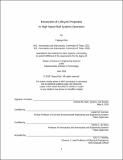Interaction of lifecycle properties in High Speed Rail systems operation
Author(s)
Doi, Tatsuya
DownloadFull printable version (5.986Mb)
Alternative title
Interaction of lifecycle properties in HSR systems operation
Other Contributors
Massachusetts Institute of Technology. Engineering Systems Division.
Advisor
Joseph M. Sussman and Olivier L. de Weck.
Terms of use
Metadata
Show full item recordAbstract
High-Speed Rail (HSR) has been expanding throughout the world, providing various nations with alternative solutions for the infrastructure design of intercity passenger travel. HSR is a capital-intensive infrastructure, in which multiple subsystems are closely integrated. Also, HSR operation lasts for a long period, and its performance indicators are continuously altered by incremental updates. With this background, design and monitoring of lifecycle properties, or "ilities", is an important factor to achieve long-term successful operation. This thesis aims to analyze and evaluate dynamic behaviors of "ilities" and their interactions in HSR operation. After the literature review and the study of industrial trends about HSR "ilities", safety, availability and profitability are chosen as key "ilities" which should be monitored in HSR operation. The Tokaido Shinkansen in Japan, and Amtrak's service in the US Northeast Corridor (NEC) are chosen as cases to study "ilities" trends. In the Tokaido Shinkansen, three "ilities" form a positive feedback loop to make HSR operation successful. The NEC shows high profitability, but it does not perform as well in terms of safety and availability due to several systemic factors. System Dynamics (SD) is applied to visualize interactions of "ilities" and other variables of interest. Qualitative causal loop diagrams (CLD) reveal several feedback loops affecting "ilities". In particular, the integration of train operation and infrastructure / rolling stock management results in the emergence of major feedback loops which cannot easily be captured by other methodologies. Qualitative SD models are converted into quantitative SD models, and numerical simulations are run to further understand the structure of causal loop diagrams. Estimated parameters in the Tokaido and the NEC suggest the different relationships among "ilities" and other variables. Further, sensitivity analyses are conducted to evaluate how different policies affect "ilities" in future HSR operations.
Description
Thesis: S.M. in Engineering Systems, Massachusetts Institute of Technology, School of Engineering, Institute for Data, Systems, and Society, 2016. This electronic version was submitted by the student author. The certified thesis is available in the Institute Archives and Special Collections. Cataloged from student-submitted PDF version of thesis. Includes bibliographical references (pages 221-224).
Date issued
2016Department
Massachusetts Institute of Technology. Engineering Systems Division; Massachusetts Institute of Technology. Institute for Data, Systems, and SocietyPublisher
Massachusetts Institute of Technology
Keywords
Institute for Data, Systems, and Society., Engineering Systems Division.